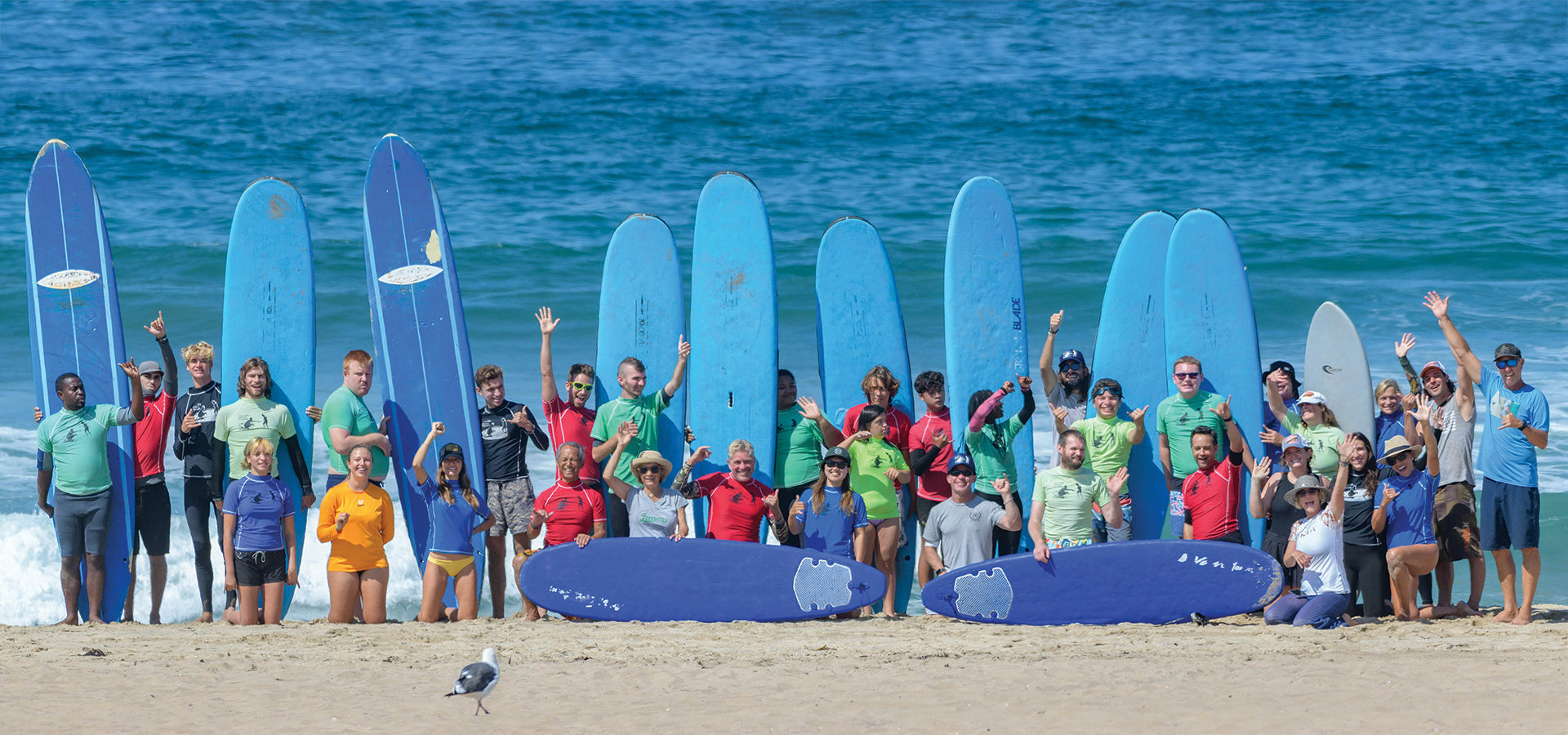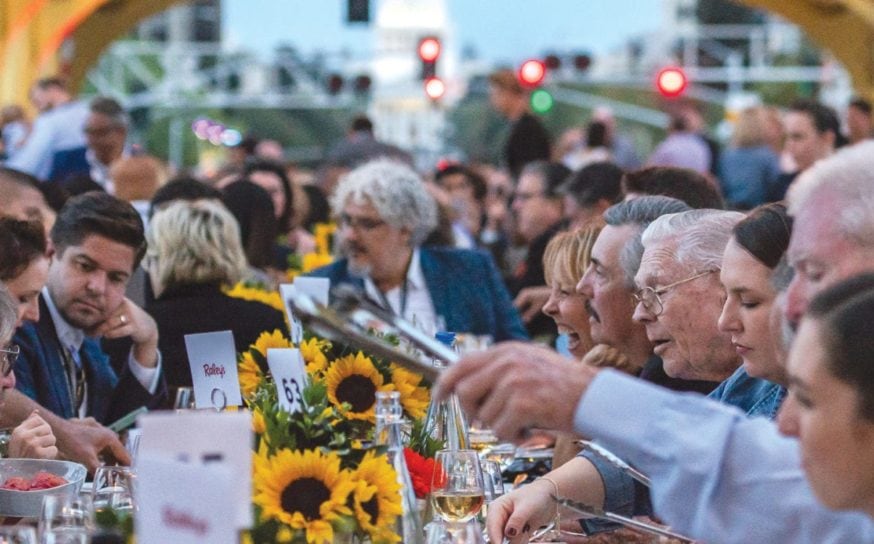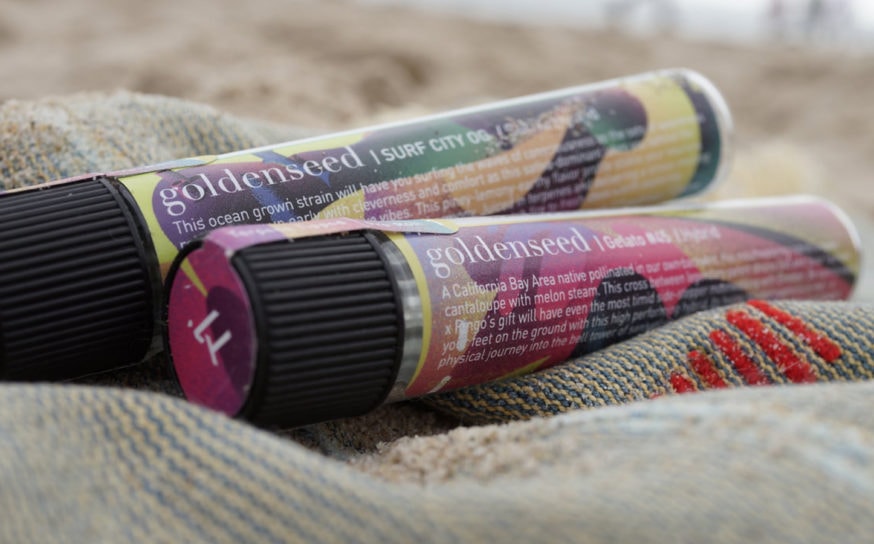The Jimmy Miller Memorial Foundation Surf Therapy Program Is Expanding Its Reach, One Healing Wave at a Time
The flow state.
-
CategoryExperiences, Giving Back
-
Written byAmber Klinck
-
Photographed byMonica Orozco & Ken Pagliaro
The Jimmy Miller Memorial Foundation (JMMF) Surf Therapy program, named in memory of the local surfer who tragically took his life in 2004, was established a year later by clinical occupational therapist Carly Rogers. Its origin was inspired by Carly’s experience as a Los Angeles County lifeguard working with the W.A.T.E.R. youth program.

While teaching ocean safety to kids with special needs and from underserved communities, Carly was moved by the restorative power the ocean was having on her young students. The therapeutic effect was undeniable with each smile, each increased level of confidence and self-efficacy. For a moment in time, the participants were focused only on themselves and the waves.
“That’s what Surf Therapy is all about,” says JMMF’s program director Kevin Sousa, who is also a licensed marriage and family therapist. He describes the program as “connection and being in a flow state. You are present, centered and aware in that moment.”
In 2007, with consistently positive feedback from young participants, JMMF extended its Surf Therapy program to serve another demographic. After a continuous dialogue with the Pentagon and the command at Camp Pendleton, JMMF created a program for the Wounded Warrior Battalion-West. While the source of trauma was different for young participants living in underserved communities or struggling with domestic abuse compared to the men and women returning from war, the PTSD, anxiety, depression, social isolation and suicidal ideation were very much the same.
The introduction of Surf Therapy at Camp Pendleton wasn’t intended to replace the therapy Marines were receiving through the VA or their battalion. It was meant to offer an alternative to traditional therapy, and the cathartic release participants were experiencing in the water was palpable.
“That’s because it breaks down barriers and establishes trust so quickly—trust that would take months of talk therapy or face-to-face therapy—because your life depends on the other person you’re working with in the ocean,” Kevin explains.
Andy Dellenbach, CEO of JMMF, shares some of the feedback he received: “[The Marines] commented that being in the ocean with its dynamic nature and ever-changing conditions was like being in a firefight or a war. In combat, the situation is dynamic—it’s always changing. You’re not sure what the enemy is doing or planning or what comes next. You don’t know where the next bullet is coming from. After they did the ocean therapy session, they went back into their group therapy and said that was the closest thing they could experience to war, to a dynamic combat environment, but with positive memories instead of haunting nightmares.”
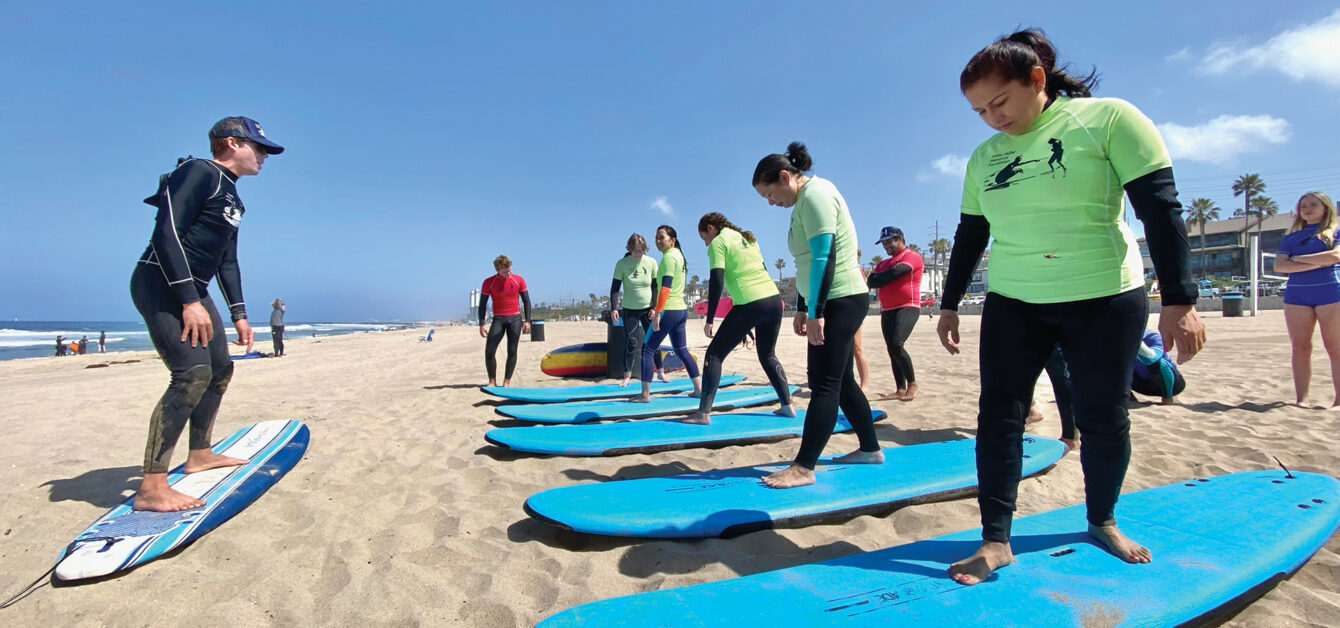
A Surf Therapy program designed to serve veterans quickly followed, with female-only veteran sessions introduced in 2013. JMMF has proudly provided Surf Therapy to more than 500 active-duty and veteran participants annually ever since. With the uncertainty that came with COVID-19, however, everything came to a halt.
“When the pandemic hit in early 2020, we got shut down. We weren’t allowed to conduct our sessions. Nobody could go on the beaches. You couldn’t gather. Everybody was, as you know, completely freaked out,” Andy notes. “We know from experience that for people who are already suffering from mental health issues, forcing them into quarantine or isolation is the worst thing that could happen to them. Knowing that sitting on the sidelines and doing nothing until the pandemic was over was not a solution, we huddled up via Zoom and tackled the question: ‘What are we going to do to help?’”
Kevin proposed leading participants through a series of virtual guided meditations. “We would use images from Brent Broza, who is one of our board members and was Jimmy’s best friend growing up. They’re beach scenes that he blurs. It’s a cool, soothing look,” Andy says. “In the fall of 2021, restrictions thankfully eased and we started getting back on the beach.”
But while COVID-19 cases began to subside, a new mental health crisis was beginning to emerge. “Doctors and nurses were having to make life decisions for people—partially because families were not allowed in the hospitals,” Andy notes. “It was traumatic for them, and what we started to see was the mental and emotional breakdown of health care givers. We realized they were starting to suffer from the same PTSD symptoms that we saw in the soldiers coming back from war. They were in a war against an enemy they didn’t understand. They didn’t know what the long-term ramifications were. They didn’t know how to effectively deal with it. It was a dynamic enemy that wore them down and caused them to go into anxiety mode. A lot of them understandably shut down. Many called it emotional burnout; they had no more to give.”

Courtney Herron has been a nurse for nine years, seven of which have been at Providence Little Company of Mary Medical Center. During the pandemic she worked six days a week, 12-hour days.
Running out of space for patients, Courtney helped open beds and create units that didn’t exist. “We used gurneys and put them in the gift shop—making units wherever we could because we didn’t have space for all the patients we were getting,” she explains. “The first couple months were rough because we had no clue what to do or what we needed. After a while we started learning what we needed, but then we didn’t have the supplies. So we were trying to come up with inventive ways to work around our problems. It was really difficult for a long time, and I think it scared us more than we realized—especially looking back.”
When Courtney saw a JMMF Surf Therapy flyer at the hospital, she was excited about an opportunity to get in the water—but only as a recreational activity. “I had no clue about the psychological factor. I guess I didn’t do my research,” Courtney says. After her first session, she knew she was experiencing something special. “I got emotional. It was unexpected. I got really moved by it all.”

Cari Carver, Torrance Memorial Medical Center’s director of finance, needed a little more nudging before agreeing to get on a board. Torrance Memorial’s coordinator, Justin Ficke, popped into Cari’s office, hoping her participation might encourage others at the hospital to give Surf Therapy a try.
“I had never in my life wanted to surf—not even an inkling—but I said, ‘OK, I will try it,’” Cari notes. Immediately, she was hooked. “It was very challenging, but the staff at JMMF is so fantastic and encouraging. I was under a lot of stress with my job, [but while you’re surfing] you can’t think of anything stressful. All your concentration is on what you’re doing with that surfboard and the feel of the water. At first it’s scary, those waves coming in, and then it’s just soothing.”
Now Cari encourages her colleagues to get out of their comfort zones and into the water. “We did get a few people to join who would not normally—once they saw the rest of us having fun,” she says. “The friendships that I’ve made and the acceptance that they give everybody regardless of their age, their background or whatever else they might be facing—it’s a safe place to be.”
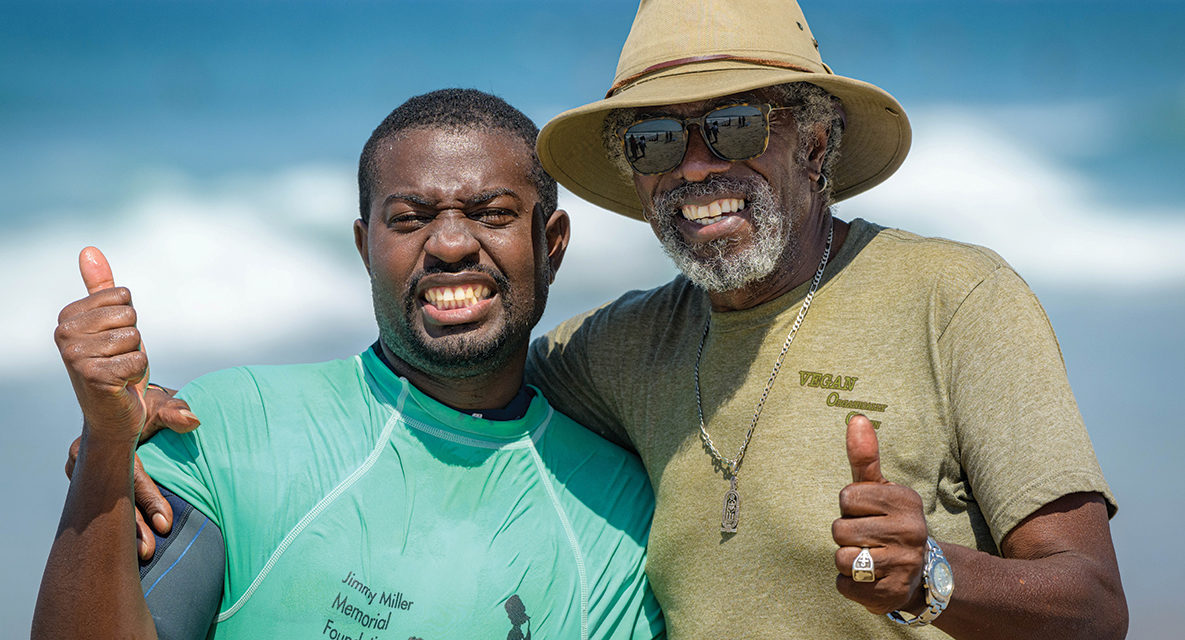
Surf Therapy can offer an emotional reprieve from trauma, but it’s perhaps the sense of community it provides that leaves the longest-lasting impression. Which is why a collaboration between the JMMF and the Friendship Foundation, an organization that supports families of children and young adults with special needs, has been such a successful pairing. When the Friendship Foundation’s program development director, Daniel Stump, began exploring a partnership with JMMF, he sat in on a Saturday Surf Therapy session.
“I had been there for maybe 15 or 20 minutes and was like, ‘Yes, we have to do this.’ We’ve done two at this point, but the first one was magical. Every single participant was in the water. And with the population that we serve, that’s most certainly not a guarantee across the board,” Daniel notes.
“I love working with [the Friendship Foundation] because you can see in their face and their body language the way they get so excited without filters,” Andy says. “We’re all conditioned to suppress or temper our emotions for societal norms, to control it and not necessarily show the totality of our emotions. But they do.”
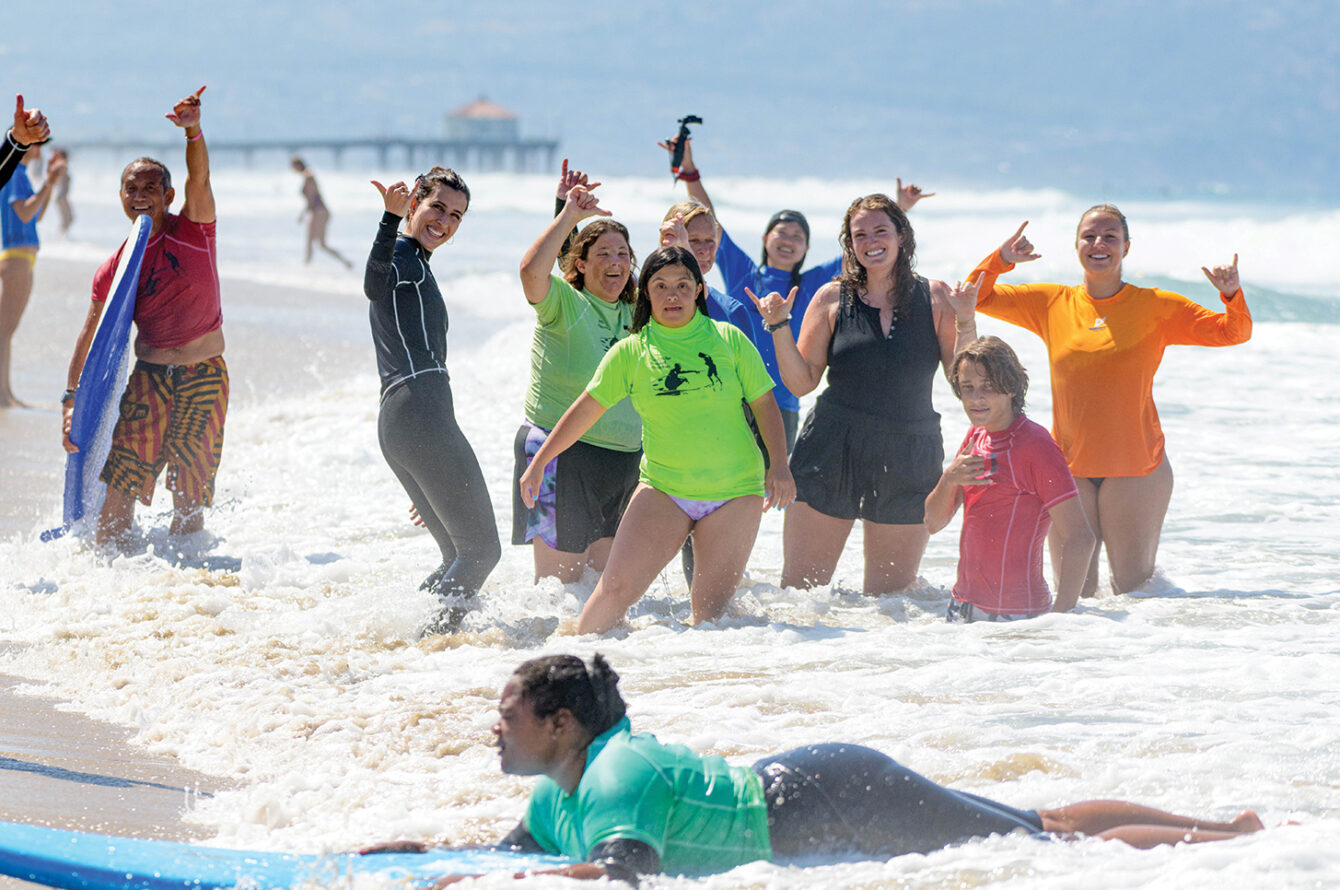
The joy, confidence and sense of accomplishment participants feel are invaluable. But so is the experience of the family members observing their loved ones from the sand. “A lot of the parents come and set up their beach chairs and umbrellas and watch as spectators,” shares Andy. “I know a lot of parents are extremely thankful for the program.”
Regardless of age, gender or background, there are so many commonalities in these participants’ stories. “When I stepped in as CEO, my vision and goal for the foundation were pretty simple: to help as many people as our resources would allow,” Andy says.
The evolution of the JMMF Surf Therapy program continues with Andy at the helm running strategy and logistics, as well as an incredible team of volunteers and Nancy Miller, who is forever at its heart as she continues to honor the memory of her son Jimmy. “She’s at almost every session, cheering people on, giving hugs, high-fives and healing herself as we help others heal from their trauma.”
Exploring the Sites and Bites of Food-Friendly Sacramento
A handbook guide to some Capital assets.
These Golden State Eateries Helped Pave the Way for California Cuisine
Enhancing the West Coast palate
one dish at a time.
This Santa Cruz Company Is the First Cannabis Farm Cleared for a Public Stock Offering by the SEC
Will Goldenseed soar on the stock exchange?
Get the Latest Stories




